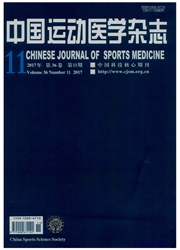

 中文摘要:
中文摘要:
目的:探讨运动训练对大鼠局部脑缺血再灌注后血管生成素及其受体表达的影响。方法:成年雄性SD大鼠42只,随机分成运动组、对照组和假手术组,每组14只。运动组和对照组采用大脑中动脉闭塞(MCA0)法造模24h后,运动组进行跑台训练,速度为12m/min,每天30min,连续2周;假手术组进行相同的造模手术,但不造成缺血。2周后采用免疫组化法观察大鼠脑缺血再灌注后Ang-1、Tie-2表达的空间分布情况,Western blot定量检测Ang-1及其受体Tie-2的表达。结果:免疫组化染色显示,Ang-1及其受体Tie-2阳性细胞主要分布在缺血侧的额顶叶皮层。Western blot结果显示,2周后,运动组Ang-1及其受体Tie-2的表达显著高于对照组(P〈0.05)。结论:运动训练可上调Ang/Tie-2通路的表达,这可能是其促进脑缺血性损伤后大鼠神经功能恢复的内在原因之一。
 英文摘要:
英文摘要:
Objective To investigate the effect of physical training on the expression of angiopoietin (Ang-1) and its receptor Tie-2 after focal brain ischemia. Methods Right middle cerebral artery occlusion (MCAO) was operated in 42 male adult Sprague-Dawley rats (2-3months old, n=42) for 60 minutes. All rats were randomly assigned into following three groups: physical training group, control group and sham operation group. 24h after MCAO, physical training group underwent 30-min treadmill training per day at a speed of 12m/min for 2 weeks. 2 weeks after MCAO, immunohistochemistry was used to observe the spatial distribution of Ang-1 and Tie-2 in the brain; Western blot was applied for the quantitative detection of Ang-1 and Tie-2. Results After two weeks, immunohistochemical staining showed that Ang-1 and Tie-2 positive cells were mainly distributed in the ischemic parietal cortex; Western blot showed that the expression of angiopoietin-1 and Tie-2 were up-regulated in the training group(P〈0.05)when compared with those in control group. Conclusion Physical training could up-regulate the expression of angiopoietin and its receptor Tie system after focal brain ischemia, leading to the improving of neurological function.
 同期刊论文项目
同期刊论文项目
 同项目期刊论文
同项目期刊论文
 期刊信息
期刊信息
